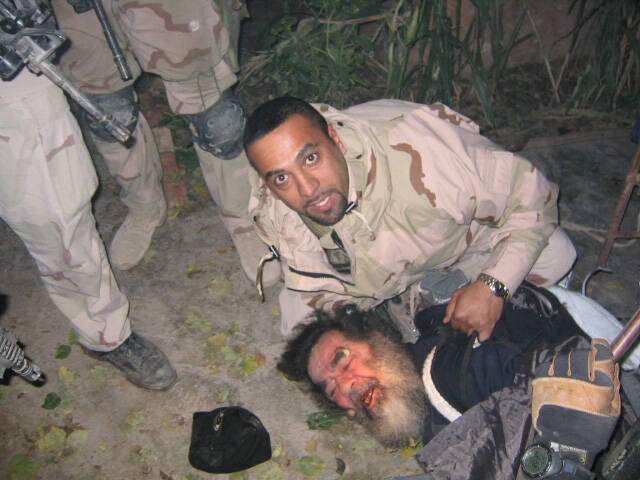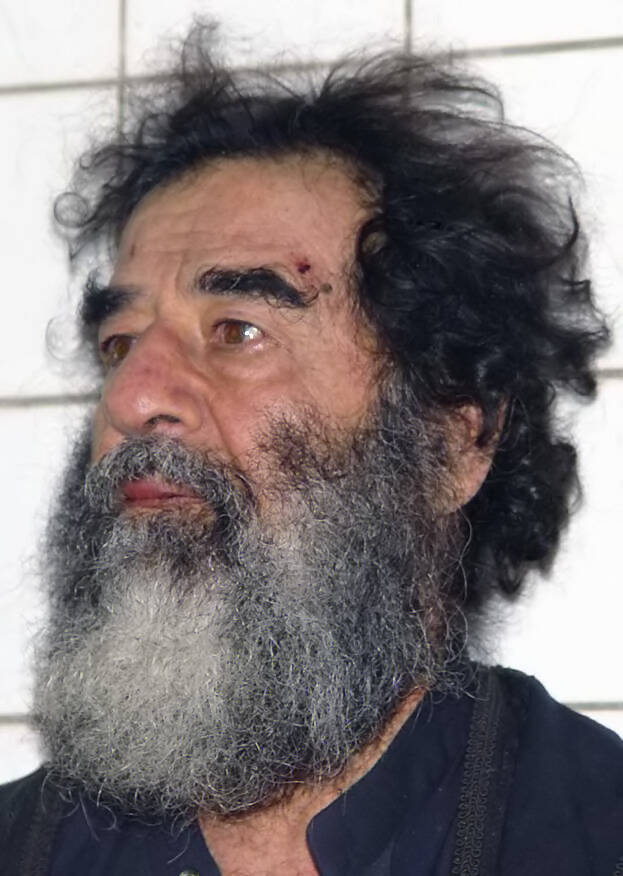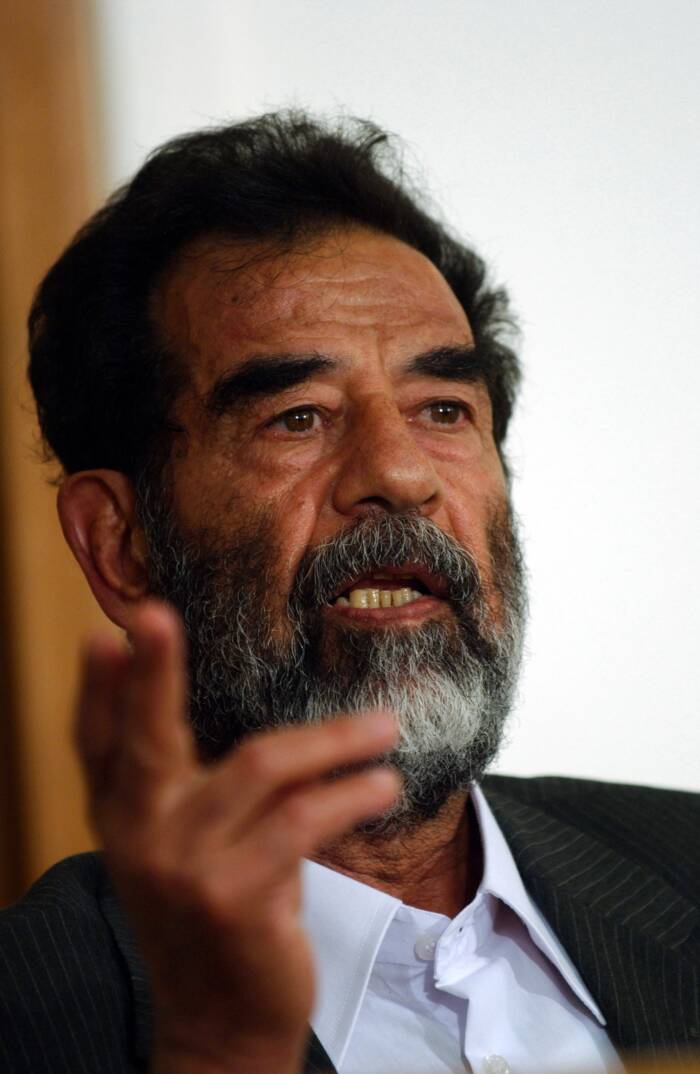Beginning in March 2003, U.S. troops carried out a dozen missions in an effort to locate Iraqi dictator Saddam Hussein — but nine months passed before they finally found him hiding in a tiny hole near a rural farmhouse.

Wikimedia CommonsSamir, a 34-year-old Iraqi-American military interpreter, posing with a captured Saddam Hussein.
In 2003, the United States was trying desperately to capture Saddam Hussein. He had largely disappeared from public view following the American-led invasion of Iraq earlier that year, with the U.S. military then designating the dictator as “High Value Target Number One.”
The search for Saddam lasted nine months, and a dozen raids ended unsuccessfully when forces were unable to locate him. Finally, in December 2003, U.S. soldiers raided a home in Baghdad. There, they found Mohammed Ibrahim Omar al-Muslit, Saddam’s comrade who provided vital information about the deposed president’s whereabouts.
Using all of the gathered intel, military officials were able to determine two possible locations where they might find Saddam.
Thus began Operation Red Dawn, the mission that ultimately led to Saddam Hussein’s capture.
How Saddam Hussein Rose To Power
Long before Saddam Hussein’s capture and the two wars that preceded it, he was born in the small village of Al Awja, Iraq, on April 28, 1937, and he endured a rather traumatic upbringing.
Before he was born, both his father and brother died of cancer, leaving his mother depressed and alone. She tried to abort her pregnancy and kill herself as a result, though both attempts were unsuccessful. When she eventually remarried to a man named Ibrahim al-Hassan, her new husband was often abusive to Saddam, sometimes beating him to wake him up.

Wikimedia CommonsA young Saddam Hussein while he was a shepherd in his small village.
When he was around 10 years old, he decided to flee his home and head to Baghdad. He eventually went on to study law, then dropped out in the early 1950s to join the Arab Socialist Ba’ath Party while working as a secondary school teacher.
The Ba’ath Party was a pan-Arab political party with strong support primarily in Syria. At the time Saddam joined, however, the number of Ba’athist supporters in Iraq measured somewhere around just 300 people. Saddam’s uncle, Khairallah Talfah, with whom he lived after leaving his abusive home, had also been a major Ba’athist supporter.
Ba’athists were further inspired by the rise of Gamal Abdel Nasser, Egypt’s second president and one leader of the 1952 revolution that toppled King Farouk and introduced a period of significant change in the country. Nasser’s revolution and rise influenced countless others across the Arabian region to rise up as well.

Wikimedia CommonsGeneral Abd al-Karim Qasim, the revolutionary who toppled the Iraqi throne.
And so, in 1958, Iraqi army officers led by Abd al-Karim Qasim staged a coup against their final king, Faisal II. However, Qasim did not subscribe to the Ba’athist ideal of pan-Arabism and instead operated on an “Iraq First” line of policy.
Because of this, many Ba’athists grew frustrated with Qasim — and began plotting his assassination. Among the men selected to carry out the operation was Saddam Hussein. According to historians Jerrold M. Post and Amatzia Baram, though unsuccessful, the assassination attempt gained Saddam some notoriety. Upon his return from exile in 1963, he was able to grow his influence and power until, finally, in 1976, he became the general of the Iraqi armed forces.
Three years later, he purged many of the Ba’ath Party’s leaders and thanked those who remained for their loyalty. And suddenly, Iraq belonged to Saddam Hussein.
Two Wars With The United States
For decades before Saddam Hussein’s capture, he ruled over Iraq, reigning from 1979 to 2003. He made it clear that religious and political tolerance were not principal concerns. Shortly after taking control of the government, Saddam expelled 40,000 Shiite Muslims and ordered the execution of Muhammad Baqir al-Sadr, an Iraqi philosopher who had close ties to Ayatollah Khomeini, a revolutionary from Iran who called to overthrow the Ba’athists, composed primarily of Sunni Muslims.
Two years later, on Sept. 22, 1980, Saddam ordered his military to launch an air attack against Iran, beginning a conflict that would last eight years and result in more than one million deaths.
In 1990, Iraq invaded Kuwait with 140,000 troops, marking the beginning of yet another conflict: the Persian Gulf War. In response, U.S.-led coalition forces launched Operation Desert Storm to free Kuwait from Iraqi occupation.

Wikimedia CommonsSaddam Hussein and his family in the 1980s.
The operation was ultimately successful but did little to stifle Saddam’s control. Just four years after the Desert Storm operation came to a close, Saddam was re-elected as the Iraqi president, and international relations only turned more sour when Iraq refused to cooperate with the United Nations’ weapon inspections.
Then, on Jan. 29, 2002, U.S. President George W. Bush delivered a State of the Union address in which he referred to three countries — North Korea, Iran, and Iraq — as an “Axis of Evil.”
“States like these, and their terrorist allies, constitute an axis of evil, arming to threaten the peace of the world,” he said. “By seeking weapons of mass destruction, these regimes pose a grave and growing danger. They could provide these arms to terrorists, giving them the means to match their hatred. They could attack our allies or attempt to blackmail the United States. In any of these cases, the price of indifference would be catastrophic.”

Wikimedia CommonsFormer president George W. Bush during his 2002 State of the Union address.
The United States officially began its war in Iraq on March 20, 2003, just over a year after Bush condemned the “Axis of Evil.” Although the U.S. launched its attack under the guise of seizing the country’s alleged “weapons of mass destruction,” there is no real evidence to suggest Iraq ever possessed such weapons.
The other goal, however, was a simple one: capture Saddam Hussein and free the Iraqi people from his authoritarian regime.
Operation Red Dawn And The Capture Of Saddam Hussein
Per an account of Saddam Hussein’s capture from the U.S. Army, United States forces managed to seize Baghdad within just three weeks of their occupation, but Saddam had managed to escape the city. Thus began a nine-month hunt for the deposed Iraqi president.
U.S. forces compiled a roster of High Value Targets, with Hussein being the top priority, and began to capture prominent members of his regime. They quickly realized, however, that his government had become entirely disjointed once the regime fell, and former political leaders weren’t going to be of any use when it came to Saddam Hussein’s capture.

Wikimedia CommonsA photograph of Saddam Hussein taken shortly after his capture by U.S. forces.
Instead, U.S. intelligence officers decided it would be better to interrogate lower-level members of Saddam’s regime, such as drivers and cooks. Officials thought they might have more reliable information on the dictator’s whereabouts.
On Dec. 1, 2003, a former driver of the regime gave investigators the name of Muhammed Ibrahim Omar al-Musslit, one of Saddam’s right-hand men. After interviewing al-Musslit’s family, soldiers carried out a raid on Dec. 12 and located the man himself. He then gave up information about where Saddam might be found.
Using this information, elite Special Operations team Task Force 121 and the 1st Brigade Combat Team of the U.S. Army’s 4th Infantry Division undertook Operation Red Dawn to finally capture Saddam Hussein. Soldiers ultimately found him in a “spider hole” in rural Ad Dawr, Iraq.
“I am Saddam Hussein,” he told the soldiers when they removed the Styrofoam covering the hole. “I am the President of Iraq, and I am willing to negotiate.”

Wikimedia CommonsFormer Iraqi president Saddam Hussein at his trial.
Saddam Hussein was ultimately put on trial under the Iraqi Interim Government after being handed over by the United States in June 2004. He was charged with crimes against humanity — and found guilty.
Despite Saddam’s frequent protests that their authority was not recognized and that he was still the president of Iraq, the court sentenced him to hang. He instead requested death by firing squad.
Two days before he was executed, the Arab Socialist Ba’ath Party website uploaded a letter written by Saddam. In it, he urged the Iraqi people to embrace “brotherly coexistence” and asked them not to hate the citizens of the countries who had invaded Iraq, such as the U.S., but rather the decision-makers who called the shots.
He closed the letter by positioning himself as a martyr, saying he was willing to sacrifice himself for his people.
After reading about Saddam Hussein’s capture, see inside his lavish palaces with our gallery of 33 photos. Then, learn about the mysterious fate of his first wife and cousin, Sajida Talfah.





